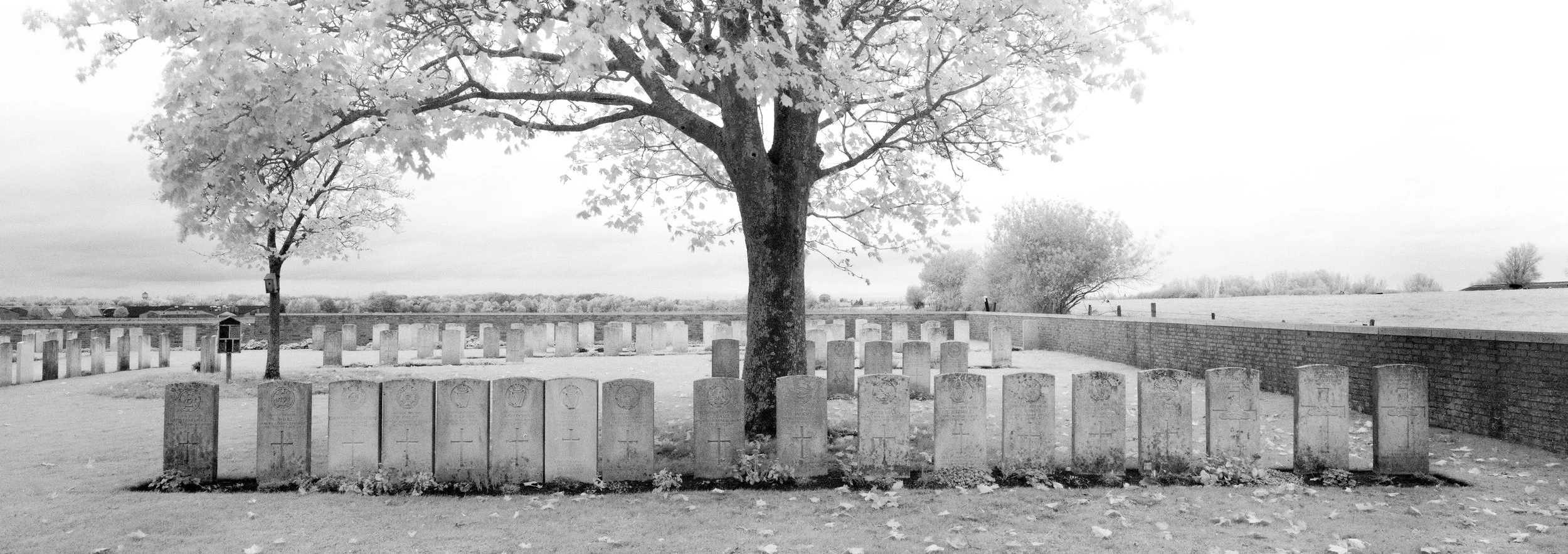
Trees bystanding buried WWI soldiers
a timeless bond
In the landscapes of the Western Front, the presence or absence of trees profoundly shapes the emotional atmosphere of remembrance. At cemeteries such as Courcelette, trees creating an impression of shelter. Birds, rustling leaves, and the play of light and shadow introduce movement.
By contrast, cemeteries like Redan Ridge Cemetery No. 2 and No. 3, where the Cross of Sacrifice rises starkly from treeless ground, convey a different emotional register. The open terrain, stripped of vertical life, amplifies the isolation of each grave. The absence of trees exposes the cemetery to the full force of wind and weather, leaving the Cross of Sacrifice as the sole point of elevation and focus. Its white stone becomes both symbol and sentinel—standing alone where once men did. In these spaces, the viewer confronts the landscape’s raw bareness; remembrance feels austere, absolute, and unsoftened.
Beaumont-Hamel newfoundland memorial
At Beaumont-Hamel the landscape itself tells the story: the preserved trenches, the undulating scars of shellfire still etched into the earth. Here the Newfoundland Regiment was nearly wiped out on the morning of July 1st, 1916.
for Newfoundland, it was, and remains, a wound woven into its identity. The regiment’s near destruction in a single hour devastated communities so small that nearly every village, every cove, felt the loss directly. Sons, brothers, fiancés — gone together. Entire generations thinned in a moment.
In Newfoundland, July 1st is still both a day of mourning and of pride. Before Confederation with Canada, it was their own Memorial Day — a day not of fireworks, but of silence. The caribou statue at Beaumont-Hamel faces the direction from which the soldiers advanced, as if still watching over them.
Walking there in 2025, one might feel that sense of distant yet enduring connection. The memorial does not glorify war; it sanctifies remembrance. There is sorrow and resilience in equal measure. The visitor feels that Newfoundland’s loss was not just military, but human and cultural — the shattering of innocence in a place that had sent its best and brightest across an ocean to die on foreign soil.
The emotional relationship between trees in a cemetery of fallen soldiers is one of quiet companionship, shared grief, and enduring witness. Each tree, standing over the graves, might seem to hold the weight of memory in its roots and branches. Their roots intertwine beneath the soil, as though they share the silent knowledge of what lies there — the lives cut short, the histories buried in silence.
In spring, their leaves signify renewal. In autumn, they shed their leaves like tears, covering the ground. In winter, bare and still, they stand vigil, guardians of memory.
Between them there is a kind of wordless solidarity — not sorrow alone, but also dignity, patience, and a quiet endurance that mirrors the courage of those they shelter..
The German cemetery at Langemark stands in quiet contrast to the surrounding Flemish fields. Its dark basalt crosses and the mass grave at its centre evoke a somber intimacy that feels heavier than the open order of Allied cemeteries nearby. Beneath the oaks, the shadows seem permanent. For the people living in and around Langemark today, the cemetery is no longer a foreign enclave of the defeated, but part of the landscape’s moral and emotional fabric. Children grow up cycling past the low walls and dark stones, learning that memory in Flanders is shared.
Because of the presence of so many young German soldiers, many of them still teenagers, their resting place invites empathy ; grief here is not national but human. The contrast between the Allied cemeteries’ brightness and Langemark’s shadowed solemnity reminds the living that remembrance has many languages: one of light, one of quiet endurance.
Set on the gentle rise near Ypres, Chester Farm Cemetery holds the traces of both order and fragility. The site itself was once a field dressing station close to the front. The cemetery’s modest scale and its surrounding trees create a sense of intimacy. It is not grandeur but quiet dignity that defines Chester Farm.
Among the Trees: Tyne Cot and Bedford House
In the black and white stillness of these images, the trees become more than part of the landscape—they are the landscape’s memory made visible.
At Tyne Cot, the trees stand at a distance, as if in quiet witness to the vast geometry of stone. Their restrained presence mirrors the order and discipline of the rows they overlook. Against the white headstones and open sky, each dark trunk feels like a pause in the silence—a vertical echo of endurance among the endless horizontals of loss.
At Bedford House, by contrast, the trees gather close, their branches weaving a canopy of intimacy. Here, light filters softly. The place feels sheltered. The trees draw closer, softening the lines of the cemetery. Light moves through their branches
Having visited battlefields and cemetries of WW-1 and WW-2 before, this was the first time for me taking a camera and purposly visit the area with the intention to take photographs. It was organised by photographer Jeremy Walker and WW-1 battlefields historian Stuart Adlam. Jeremy is a UK -based photographer particularly interested in these battle grounds sinds so many British lost their lives here, including members of his early generation of family. Stuart has been a volunteer for more than 25 years to the Commonwealth War Graves Commission. His work involves visiting cemeteries, recording war graves, and ensuring they are maintained in good condition as part of the CWGC's "Eyes On, Hands On" project. In their collaboration, Jeremy and Stuart provided an in depth experience of these battlefields, which I hope is reflected in these images.
All images were taken with the fuji G617 panoramic camera on Tri-X 400 film and one on SFX200













